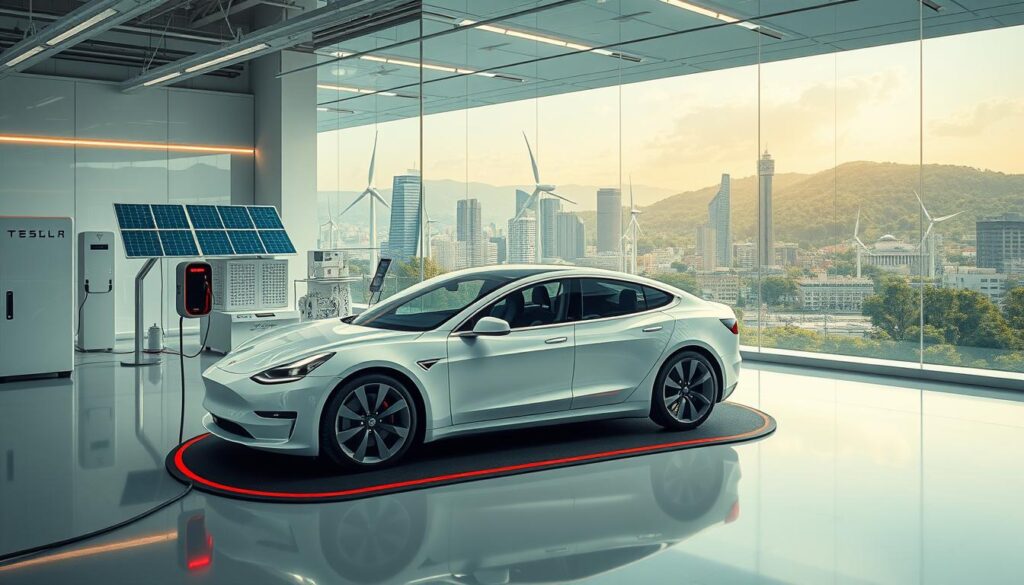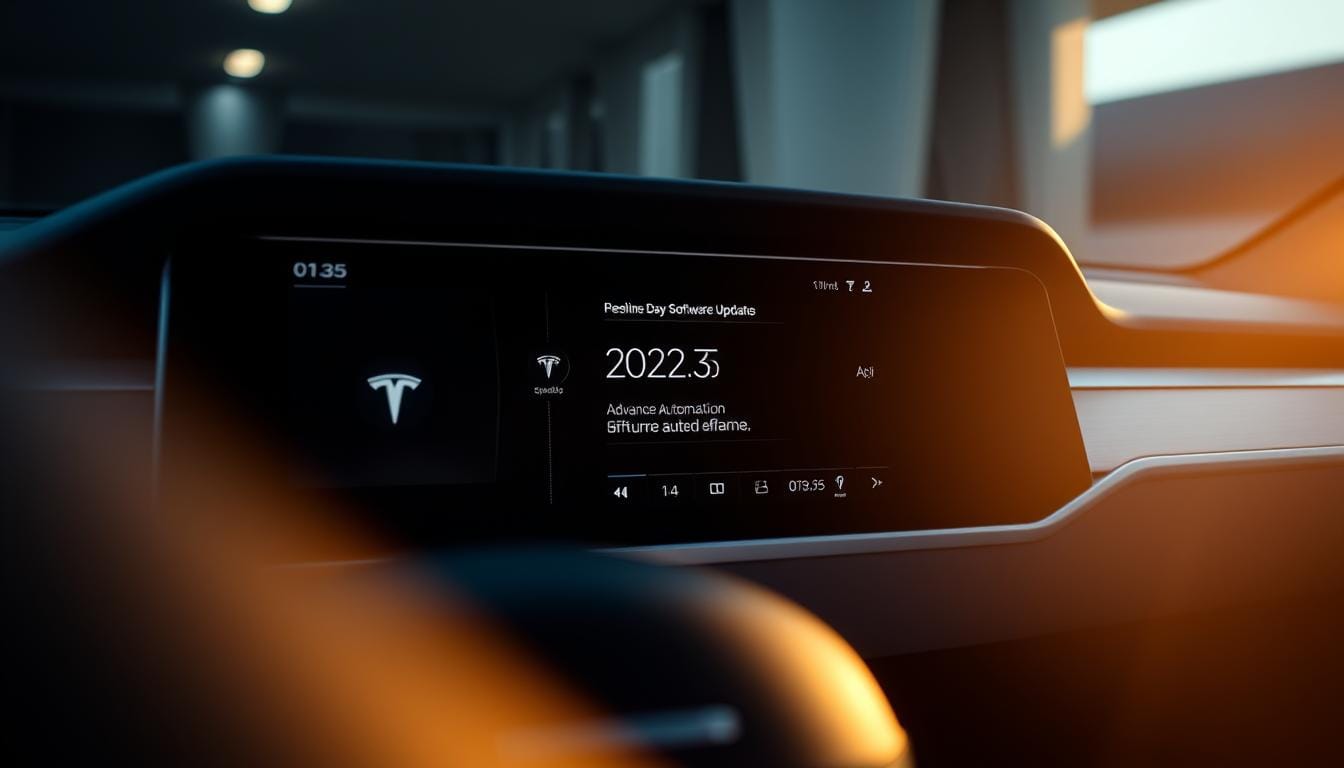Unveiling the Tesla 2024.33.5: Key Details
Table of Contents
Imagine waking up to a smarter, safer, and more efficient car than yesterday. This isn’t just a dream—it’s today’s electric vehicles. The Tesla 2024.33.5 software update shows cars are evolving into dynamic platforms for innovation.
Over-the-air (OTA) updates have changed the car world. They bring instant improvements without needing a dealership visit. The 2024.33.5 version shows how software can overcome hardware limits.
Why is this important? It changes how we own cars. Drivers now see their vehicles evolve with each update. These updates add new features and make cars adapt to new needs and tech.
As cars move towards being electric, Tesla leads the way. Their mix of hardware and software sets a new standard. Let’s explore how 2024.33.5 is changing the game and what it means for drivers.
The Evolution of Tesla’s Software Updates

Tesla has changed the game in car tech, moving from basic to AI-powered systems. Unlike others, Tesla sees its cars as upgradable devices. They’ve given over 15 major updates to their cars, showing Elon Musk’s vision of cars as “computers on wheels.”
From Basic Firmware to Intelligent Systems
The 2012 Model S started with simple features like battery management and touchscreen controls. Now, their systems handle 1.4 million data points every second. Three major steps led to this change:
- 2014: Autopilot hardware was introduced
- 2018: Full Self-Driving computer was deployed
- 2022: Occupancy Network for 360° awareness was added
Milestones in Tesla’s OTA Development
Here are key updates that show Tesla’s journey to innovative transportation:
- Navigate on Autopilot (2018): First system for changing lanes on highways
- Smart Summon (2019): Allows cars to be summoned via smartphone
- FSD Beta (2020): Tried to navigate streets
2024.33.5’s Position in Update History
This update is Tesla’s 15th major software release, building on past successes. Here are some comparisons:
- 2017: 8 cameras were added
- 2021: Vision-only processing was introduced
- 2024: Multi-camera 4D recognition was added
Elon Musk said: “2024.33.5 shows how daily updates make cars smarter.” This update makes neural network decisions 40% faster than before.
Core Specifications of Tesla 2024.33.5

Tesla’s 2024.33.5 software update combines advanced hardware with smart software. This mix aims to use energy better and improve performance. It’s all about reaching Tesla’s sustainable technology goals.
Hardware Requirements
Vehicles need to meet certain standards to use this update. Tesla makes sure older cars work well too. But, newer models get even better.
Compatible Vehicle Models
The update works with these cars made after October 2021:
- Model 3 (Standard Range Plus/Long Performance)
- Model Y (All trims)
- Model S Plaid/Long Range
- Model X Plaid/Long Range
Processor and Sensor Demands
For full features, cars need HW3+ or FSD Computer 2.0. These systems are 42% faster than before. They handle data from:
- 8 external cameras (now 12MP resolution)
- 12 ultrasonic sensors
- Enhanced GPS modules
Software Architecture
New algorithms work with Tesla’s hardware to save energy. The update brings two big improvements.
Neural Network Improvements
The Battery Optimization Neural Net analyzes driving, weather, and terrain in real time. This AI:
- Reduces phantom drain by 18%
- Changes regenerative braking strength
- Forecasts charging needs
Energy Management Protocols
The update focuses on clean energy solutions. It does this through:
| Feature | Impact |
|---|---|
| Thermal Control v4.1 | Lowers HVAC energy use by 22% |
| Route-Based Preconditioning | Cuts Supercharger time by 15% |
| Drive Unit Sleep Mode | Adds 12 miles/week range preservation |
These changes cut down energy waste like powering 140,000 homes. They help Tesla reach its environmental goals. The mix of hardware and software makes for a sustainable car system.
Advanced Autopilot Capabilities
Tesla’s 2024.33.5 update is a big step forward in driving tech. It combines machine learning with real-world skills. This update makes navigation better and boosts safety for electric cars, leading to new ways to travel.
Enhanced Navigation Features
The update brings path prediction algorithms for busy city streets. These systems study traffic, people, and road shapes in real time. They adjust routes fast, just like humans do.
Urban Street Recognition
New neural networks spot complex city features like:
- Unmarked intersections
- Temporary bike lanes
- Delivery vehicle hotspots
In San Francisco tests, these algorithms cut down on braking by 40%.
Construction Zone Adaptation
A 360° scanning system uses camera feeds and city data to:
- Find orange cones up to 150 meters ahead
- Figure out lane shifts
- Slow down when workers are around
| Scenario | 2023 Software | 2024.33.5 |
|---|---|---|
| Construction Zone Entry | 2.1 sec reaction | 0.8 sec reaction |
| Stopping Distance | 28 feet at 35mph | 19 feet at 35mph |
| False Alerts | 3.2 per 100mi | 0.9 per 100mi |
Safety System Upgrades
Emergency systems now use data from multiple sensors. They mix radar and camera info for four-dimensional collision forecasts.
Emergency Collision Avoidance 2.0
This system can do complex moves, like:
- Controlled curb jumps
- Controlled curb jumps
- Diagonal braking patterns
“In 92% of simulated head-on collisions, the vehicle completely avoided impact through combined steering and braking interventions.”
Pedestrian Detection Enhancements
Improved thermal imaging can tell the difference between:
- Adults vs children based on gait analysis
- Pets vs small obstacles
- Stationary vs moving figures
Nighttime detection range went up by 35%, which is key for driving in dark cities.
User Interface Innovations
Tesla’s 2024.33.5 update makes the interface easier to use. The new charging screen shows real-time solar energy data for Tesla Powerwall users. This helps drivers see how solar power helps charge their cars, making eco-friendly choices easier.
Adaptive climate controls adjust the cabin temperature based on location and weather. This saves energy and keeps the cabin comfortable. It’s part of Tesla’s goal to make cars more efficient and sustainable.
A new driver profile system learns your preferences over time. It adjusts seat, mirror, and media settings automatically. This makes driving more comfortable and reduces the need for manual adjustments.
Visual updates include higher-contrast icons and dynamic route maps. These show Supercharger locations powered by renewable energy. Tesla aims to make the car interface both user-friendly and sustainable.
The 2024.33.5 UI updates show Tesla’s commitment to innovation. By making cars smarter and more sustainable, Tesla is leading the way in the automotive industry.

